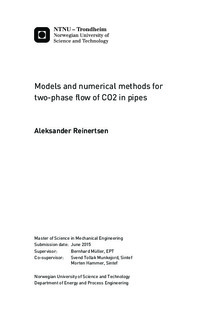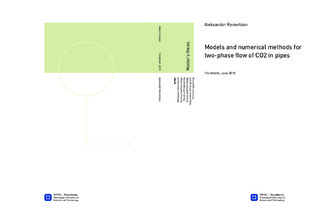| dc.description.abstract | Key to the transport phase of carbon capture and storage (CCS) is understanding the behavior of liquid or supercritical CO2 in pipelines, and the consequences of cracks and pipe depressurization. It is therefore useful to develop mathematical models and numerical methods for two-phase flow of CO2 in pipes in order to better predict such behavior. Such developed tools can also be useful in fluid structure- interaction models.
Key to simulating single or multiphase flows is the formulation of a flow model. Here, the homogeneous equilibrium model (HEM) has been used. Further, for a flow model such as HEM, closure conditions are needed, and in this thesis the Span- Wagner equation of state (EOS) has been used. This EOS is a Helmholtz function fitted to experimental data for CO2 properties, and so it is CO2-specific.
When using the finite volume method to simulate fluid flow, a numerical flux func- tion is needed. In this thesis, the advection upstream splitting method (AUSM) family of schemes has been investigated and compared to the first ordered centered (FORCE) scheme in order to evaluate the performance of AUSM-schemes.
AUSM+ up has been found to perform satisfactorily for three test cases. Due to the upstream nature of the scheme, it proved more accurate than the FORCE and Lax-Friedrichs schemes for a test case simulating the advection of a CO2 gas fraction in liquid. When compared to the results obtained by SINTEF Energy Research for a shock tube case and a depressurization case, AUSM+ up was found to reproduce all the expected solution features seen for the FORCE solution. For the shock tube case, slight differences in the evaluation of energy, temperature and velocity could be seen. Possible reasons for this could be that the solution is not grid-independent or that the flux splitting nature of AUSM schemes simply causes these variables to be evaluated slightly differently, possibly more accurately, compared to FORCE.
When simulating the shock tube and the depressurization cases, the thermodynamic solver had problems evaluating the speed of sound correctly. This did not seem to affect the solution of state variables to a large degree. These problems occurred in regions where the thermodynamic solver evaluated certain cells to be liquid phase, whereas other cells were liquid with a fractional amount of gas. Such problems were not seen for FORCE and this is a drawback for AUSM+ up.
A further drawback for AUSM+ up is that it requires parameter tuning, and the solution of the shock tube test case was parameter sensitive in order to obtain the correct solution. Another finding when comparing AUSM+ up and FORCE for the depressurization case was that the former has higher computational times for equal grid sizes. This increased computational cost is however well paid off by its better resolution compared with the FORCE scheme.
The implementation of AUSM schemes proved complicated due to the need for parameter tuning, but the scheme performed satisfactorily for all test cases. The implementation of FORCE was comparably straightforward. Thus it could be worth investigating AUSM schemes that do not require parameter-tuning. Future work could also include implementing other flow models where one would avoid regions of oscillating speed of sound. Optimization of the AUSM+ up code is also a possible future task. | |

